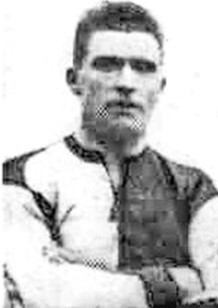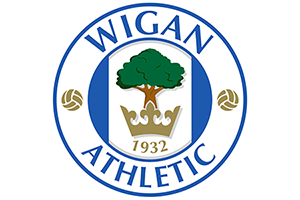George Allon - Player Profile

| Full Name: | George Thomas Allon |
| Born: | 27/08/1899 |
| Died: | 01/01/1983 (age 83) |
| Place of Birth: | Blyth |
| Nationality: | England |
| Height: | 5 ft 10 in |
| Position: | Defence |
| First Team Debut: | 27/08/1932 v Port Vale Reserves (H) - Cheshire County League |
| Signed: | 20/08/1932 (Free) |
George Thomas Allon (born 27 August 1899) was an English footballer known for his steady defensive play during the 1920s and early 1930s. Allon spent his prime years in the Football League with Coventry City and Northampton Town, before joining Wigan Athletic for their inaugural 1932–33 season. Over the course of his career, he made over 250 league appearances and was regarded as a reliable, speedy defender.
Early Life and Amateur Beginnings
George Allon was born in Blyth, Northumberland, on 27 August 1899. Growing up in England’s North East at the turn of the 20th century, Allon came of age just after World War I. Like many young men of his region, he was drawn to football. He began playing competitively with Usworth Colliery A.F.C., an amateur/miners’ team, around 1920. Though details of his youth career are sparse, playing for a colliery side suggests Allon likely balanced work (possibly in coal mining or related industry) with football. His performances at the local level were strong enough to attract attention from professional scouts. In February 1921, Coventry City – then a Second Division Football League club – signed the 21-year-old Allon from Usworth Colliery. This transfer marked the beginning of Allon’s professional career and a move south from his native Northumberland to the English Midlands.
Coventry City (1921–1925)
Allon joined Coventry City in 1921, at a time when the club was struggling in the Second Division. Initially, he played in Coventry’s reserve team, but he impressed in the reserves at the start of the 1921–22 season and was pushed into the first team following some poor results. He made his senior debut early that season and quickly established himself as a regular. Playing primarily as a right-half (wing-half) – a midfield defensive role in the classic 2-3-5 formation of the era – Allon featured in 39 league matches and scored one goal in his first full season, 1921–22. He remained a mainstay in 1922–23 with 32 league appearances that season, helping shore up Coventry’s defense.
Despite Coventry City’s overall struggles, Allon gained a reputation as a dependable defensive player. Contemporary accounts noted that he was at his best “when it came to a scrimmage or packing the goal,” meaning he excelled when the team was under heavy pressure and had to defend stubbornly. He was praised as a good defender who could be relied on when City were under pressure, throwing himself into goalmouth scrambles to block shots and clear danger. However, observers also pointed out that when Coventry were on the attack and “on top,” Allon was less effective in contributing to constructive play. This suggests that while he was a solid stopper and ball-winner, he was not as adept at creative passing or attacking support – a somewhat “enigmatic” player whose impact was greater in desperate defending than in building attacks.
Allon’s strong presence helped Coventry in defense, but the team continued to toil in the lower reaches of Division Two. In each season of the early 1920s, Coventry City was battling near the bottom of the table. After the 1922–23 campaign (in which they finished 18th of 22), the club again narrowly avoided relegation. Allon began to face more competition for his place by 1923. He lost his regular starting spot after the 1922–23 season, and over the next two years he only made sporadic first-team appearances. In 1923–24 Allon played just 4 league matches, and in 1924–25 only 3 matches (though he did score once that final season). Having been a fixture in the side for two seasons, he thus logged only seven more league appearances in his last two years at Coventry. His final game for Coventry City came in February 1925, in a bruising 0–5 defeat to Oldham Athletic. That heavy loss underscored the club’s troubles – indeed, Coventry finished bottom of Division Two in 1924–25 and were relegated to the Third Division.
After Coventry’s drop into the third tier, Allon parted ways with the club. In total, he had made 78 league appearances for Coventry City between 1921 and 1925, scoring 2 goals (numbers which reflect his initial two full seasons and a handful of later games). His solid defensive contributions had not gone unnoticed, but with Coventry restructuring after relegation – and Allon having been out of the lineup for much of the relegation season – he moved on in search of regular football again.
Nuneaton Town and Peterborough & Fletton United (1925–1926)
In the summer of 1925, Allon stepped down from League football to join Nuneaton Town, a non-league side in Warwickshire, not far from Coventry. Nuneaton Town competed in regional leagues (at the time likely the Birmingham & District League or another Midlands competition). Allon’s move in August 1925 was effectively a free transfer, allowing him to get more game time at a slightly lower level. He spent the first half of the 1925–26 season with Nuneaton Town. Details of his performances there are scant – lower-division statistics were not well documented – but as an ex-Football League player, Allon would have been one of the more experienced members of the Nuneaton squad.
Midway through that season, Allon switched clubs again, joining Peterborough & Fletton United in early 1926. Peterborough & Fletton United (nicknamed “The Brickies” due to the brickmaking industry in Fletton) played in the Southern League. The club was based in Peterborough, Cambridgeshire, and was an ambitious side in the non-league scene at the time. By signing Allon, they acquired a player with second-tier experience to bolster their ranks. While Allon’s exact number of appearances for Peterborough & Fletton United is not recorded in available sources, he was with the club for the latter portion of the 1925–26 campaign. Historical records show that Peterborough & Fletton United existed until 1932, when the club folded, to be eventually replaced by the modern Peterborough United in 1934. Allon’s short stint at “the Brickies” preceded that club’s demise by a few years.
After spending the 1925–26 season split between Nuneaton and Peterborough, Allon had proven that he could still perform, prompting a return to league football. In 1926, he signed with Northampton Town, bringing him back into the Football League (Third Division South) for the next chapter of his career.
Northampton Town (1926–1932)
Allon joined Northampton Town in mid-1926, returning to the professional league ranks. At Northampton, he found an environment where he would spend the longest stretch of his career. Northampton Town competed in the Third Division South and, like Coventry earlier, they were a Midlands club albeit in a lower tier. Allon’s arrival gave the “Cobblers” (Northampton’s nickname) an experienced wing-half who had seen higher-level competition.
Almost immediately, Allon became a key part of the Northampton Town first team. He was typically deployed as a right-half (right wing-half) but was a versatile defensive midfielder who could also fill in across the half-back line. In the 1926–27 season, his first with Northampton, Allon made 27 league appearances and scored 1 goal. As he settled in, his influence grew: the following season, 1927–28, he appeared in 45 league matches and scored 6 goals – a notable goal tally for a half-back. This 1927–28 season was arguably Allon’s best offensively, as he showed a knack for chipping in goals (possibly from set-pieces or long shots) in addition to his defensive duties. His 6 goals that year suggest he might have taken penalties or free-kicks, or simply gotten forward more often in that campaign.
Over the ensuing seasons, Allon remained a fixture in the Northampton Town lineup. He was a regular starter each year through the early 1930s:
1928–29: 35 league appearances, 1 goal.
1929–30: 35 league appearances
1930–31: 31 league appearances
1931–32: 19 league appearances in what would be his final season with Northampton.
By the end of the 1931–32 season, Allon had amassed 185 Football League appearances for Northampton Town, scoring 7 goals in league play. (Including FA Cup and other competitions, his total matches for Northampton reached 192.) These numbers cement Allon as a significant player in Northampton’s history – he comfortably exceeds the 100-match milestone and is listed among the club’s notable players for his service. Northampton Town, for their part, spent all these seasons in the Third Division South; they did not achieve promotion during Allon’s tenure, but Allon’s consistency helped the club remain competitive. In fact, Northampton was one of the ever-present teams in Third Division South throughout the division’s 30-year existence, typically finishing in mid-table. Allon’s presence in midfield contributed to the team’s stability in that period.
At age 32, after six seasons in Northampton’s first team, Allon saw his playing time decrease (e.g., 19 appearances in 1931–32 compared to 30+ in prior years). By the summer of 1932, Northampton Town released or transferred him, allowing Allon to seek a new challenge. His next move would be a noteworthy one – joining a brand new club that was making headlines in the northwest of England.
Wigan Athletic (1932–1933)
In August 1932, George Allon signed with Wigan Athletic, becoming part of the newly founded club’s first-ever squad. Wigan Athletic had just been established in 1932 after the collapse of the town’s previous club (Wigan Borough) in 1931. The formation of Wigan Athletic was the sixth attempt to create a stable football club in Wigan, a town with a strong rugby league tradition but also a desire for soccer representation. Allon’s arrival at Wigan came just in time for the club’s inaugural season (1932–33) in the Cheshire County League.
Wigan Athletic’s leadership, including player-manager Charlie Spencer (an ex-England international centre-half), sought experienced players to quickly make the club competitive. Allon, aged 32 and with over a decade of league experience, fit that bill perfectly. He was signed on a free transfer on 20 August 1932, likely to bolster Wigan’s defense with his veteran savvy. At Wigan, Allon was listed as a defender – sources refer to him as a right-back or right-half – essentially anchoring the right side of the backline or midfield in Wigan’s formation.
On 27 August 1932, Wigan Athletic played their first ever league match, against Port Vale Reserves at Springfield Park. Allon was in the starting lineup for this historic game. In fact, the first Wigan Athletic XI that day was: Harry Abbott (GK); George O’Dell, Harry Callaghan (defenders); George Allon, Charlie Spencer, Harry Wake (half-back line); William Chambers, Gus Smith, Barney McCabe, Bill Henderson, Vincent Murphy (forwards). The team wore red-and-white halved shirts with black shorts – earning them the early nickname “The Arsenal of the Cheshire League” for both the kit resemblance and their ambitious style. Over 5,000 spectators watched that debut match, underlining the significant local interest in Wigan’s new club.
Allon quickly became a cornerstone of Wigan Athletic’s side. Despite his age, he was ever-present in defense. During the 1932–33 season, Allon made 41 appearances out of 42 league games for Wigan Athletic, missing only a single match all season. He scored 0 goals – unsurprising as he now focused purely on defensive duties – but his contribution was measured in stopping goals rather than scoring them. Allon’s veteran partnership with Charlie Spencer (who served as both manager and center-half) and the rest of the backline produced impressive results. Wigan Athletic, playing in the Cheshire County League, had a very successful first campaign for a new club. They finished the season in 5th place (out of 13 teams) with a record of 21 wins, 11 draws, 10 losses, totaling 53 points. The team was competitive for the title race for large stretches of the season and even reached the semi-finals of the Cheshire League Cup.
One of the most notable aspects of Wigan’s 1932–33 performance was their defense. Latics conceded only 54 goals in 42 league games – the fewest of any team in the league that year. This stingy defense was a key reason they could thrive as a new club. Allon, as a starting defender, played an integral role in this achievement. His experience marshaling the defense helped Wigan keep opponents at bay. The team’s offensive stars (like forwards Bill Chambers and Barney McCabe who each scored prolifically) earned Wigan the nickname “Arsenal of the Cheshire League” for their attacking flair, but it was players like Allon who provided balance by keeping the opposition’s scoring low.
Wigan Athletic’s inaugural season was full of unique challenges – the club was essentially building from scratch after Wigan Borough’s demise. The presence of seasoned pros such as Allon and Spencer gave the team credibility and stability. By the end of 1932–33, Wigan had proven themselves a force in the Cheshire League, finishing only five points behind the champions (Macclesfield Town). Allon appeared in nearly every match, underscoring his fitness and consistency even in his mid-30s.
After that season, Allon’s professional football journey largely came to a close. The 1932–33 campaign with Wigan Athletic appears to have been his final season as a player. He retired from competitive football in 1933. His one-year stint at Wigan had been historically significant – not many players can say they took part in a club’s first-ever season – and it capped a long career spent mostly in England’s lower divisions.
Later Years and Legacy
Following his retirement from football, George Allon lived a quieter life away from the limelight of the game. Little is documented about his post-football occupations or whether he stayed involved in the sport locally (such as coaching or scouting), which was common for former players of that era. It is possible he returned to the North East of England or remained in the Midlands/North (he had spent many years in Northampton and then Wigan).
What is known is that George Allon passed away in 1983, at the age of 83. This means he lived to see football’s post-war changes and the evolution of the game long after his own playing days.
In total, George Allon made 259 league appearances in the Football League (74 for Coventry and 185 for Northampton) and scored 9 league goals. Including his 41 Cheshire League appearances for Wigan and earlier non-league matches, his career appearances exceed 300 games. More importantly, Allon’s career is a window into English football between the wars – a time of regional leagues, tough physical play, and clubs fighting for survival and success in difficult economic conditions (the late 1920s and early 1930s included the Great Depression). Allon played for clubs at moments of great significance: Coventry City’s first relegation in 1925, the turbulent non-league scene (Nuneaton and the short-lived Peterborough & Fletton United), and the birth of Wigan Athletic amid a community’s determination to maintain professional football in their town.
Former teammates and accounts would describe George Allon as a stalwart defender who gave his all on the pitch. While not a headline-grabber, he was the kind of player that every successful team of that era needed – hardworking, resilient, and experienced. His journey from the coalfields of Usworth to the pitches of the Football League, and finally to helping establish a new club in Wigan, exemplifies the life of a dedicated professional footballer in the early 20th century.
Wigan Athletic Career
| League | FA Cup | League Cup | Other | Total | |||||||
|---|---|---|---|---|---|---|---|---|---|---|---|
| Season | Apps | Goals | Apps | Goals | Apps | Goals | Apps | Goals | Apps | Goals | |
| 1932-1933 | 41 (0) | 3 | 0 (0) | 0 | 0 (0) | 0 | 4 (0) | 0 | 45 (0) | 3 | |
| TOTALS | 41 (0) | 3 | 0 (0) | 0 | 0 (0) | 0 | 4 (0) | 0 | 45 (0) | 3 | |


